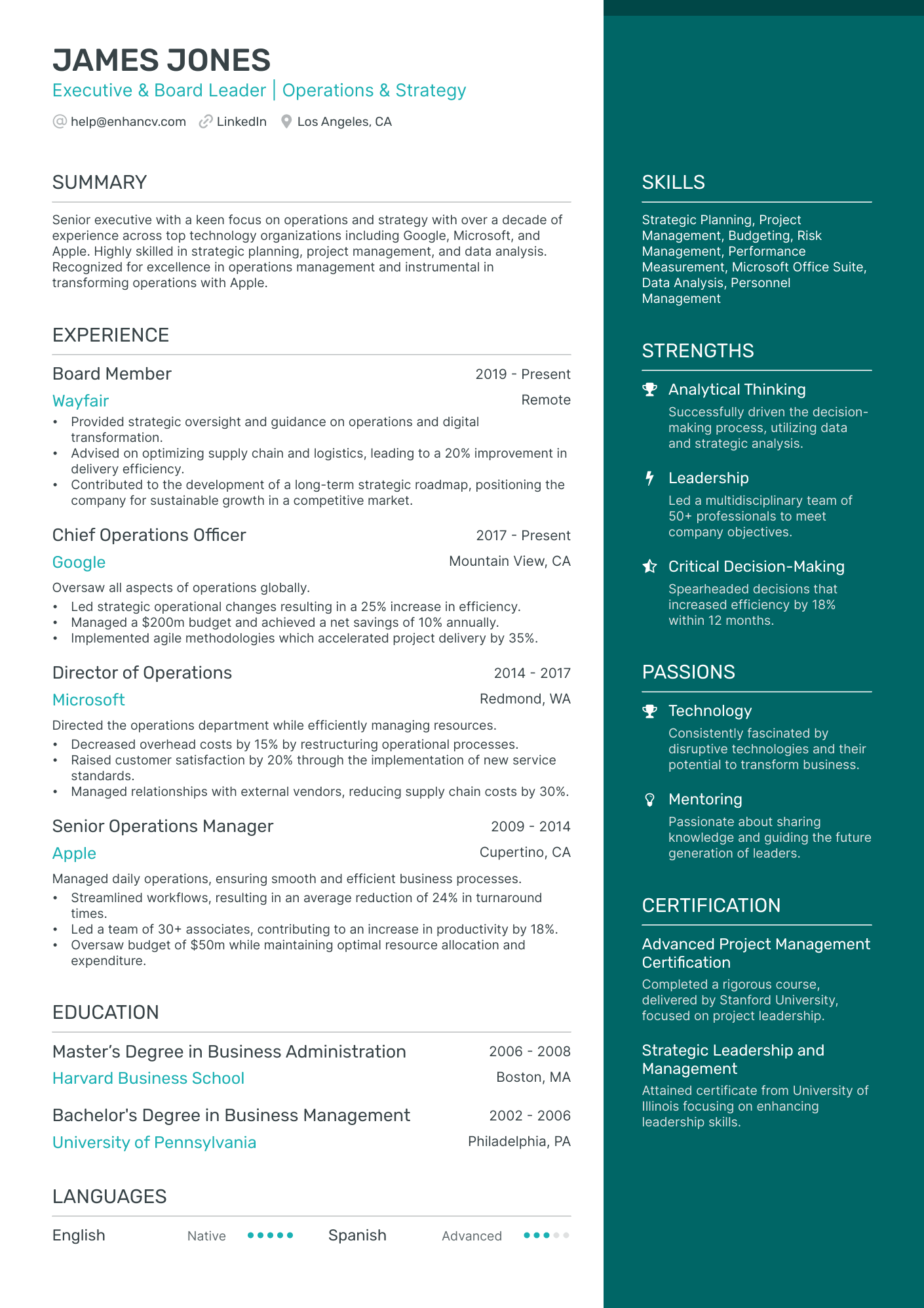Board memberships aren’t just a fancy title hanging on your resume. They can be a testament to your dedication, seriousness, and reliability. Yet, many professionals hesitate to include them, unsure if they fit or if they’ll be perceived as irrelevant.
Should you list them? Will it make your resume look cluttered or off-topic? In reality, when displayed effectively, board roles highlight key skills like leadership, strategic thinking, and collaboration—qualities that employers in leadership positions seek.
What is a board membership?
The board of directors is a part of the structure of various companies. Its main role is to oversee an organization’s strategic direction and overall performance, by providing vision and governance. The board serves as the highest governing body, responsible for making major decisions.
Types of boards
Depending on their function, company boards can be a/an:
- Governing board (Board of directors): Responsible for overseeing an organization's strategy, governance, and financial health.
- Advisory board: Provides non-binding, strategic advice to the organization’s leadership without governing authority.
- Non-profit board: Oversees the mission, governance, and fundraising efforts of a non-profit organization.
- Corporate board: Focuses on ensuring that a for-profit company operates in the best interest of shareholders.
- Executive board (Executive committee): A smaller subset of the main board that makes quick decisions on urgent matters.
Due to the typically smaller budget of non-profit organizations, board members often take on additional day-to-day responsibilities.
Additionally, there are notable differences between traditional and modern board members. As Anders Jorgensen writes, while the classic board profile relies more on experience and stability, which involves long-term relationships and established routines, modern board members adapt to the needs of the contemporary world, which include adaptability, risk-taking, and new methods, approaches, and contacts.
Why should you include board membership on your resume?
Featuring board membership on your resume proves your expertise, involvement in a cause bigger than yourself, dedication, leadership, and business skills. It’s particularly beneficial for those aspiring to leadership or executive roles but can enhance resumes for various positions, provided the qualities it highlights are relevant to the job ad.
Serving on a board is proof of a wide skillset that demonstrates a deep understanding of how organizations operate at a high level, which is critical for anyone aiming to move into senior leadership roles. Let’s explore the key skills developed through board membership.
Best skills for a board member
- Strategic thinking
- Governance expertise
- Collaboration
- Industry knowledge
- Financial acumen
- Risk management
- Leadership
- Decision-making
- Ethical judgment
- Communication skills
- Crisis management
- Analytical skills
- Adaptability
- Innovation mindset
- Networking
- Conflict resolution
- Cultural awareness
- Negotiation skills
- Mentorship
- Regulatory compliance
When not to include board membership on a resume
Sometimes, it just doesn’t make sense to include a board membership on your resume. Consider leaving it out in these instances:
- Your tenure was short or your responsibilities are irrelevant to the position you’re after.
- The board experience you have doesn’t include tasks that could relate to the job you're pursuing.
- The organization isn’t well-known, and mentioning it might require extensive explanation or raise more questions than it answers.
- The board role was in a controversial organization that might conflict with the values of the company you’re applying to.
Are all board members experts in the specific field of the board? Not necessarily. Diversity of experience is important because someone from outside the industry can challenge assumptions, ask different questions, and bring fresh ideas.
Take Bill Gates, for instance. The co-founder of Microsoft served on the board of Warren Buffett's Berkshire Hathaway. While his experience in technology may seem far removed from Berkshire's insurance and investment businesses, his strategic thinking and innovation made him a valuable board member.
How to list board membership on your resume
When listing board membership on your resume, consider the following:
- The type of board you’re on (e.g., corporate vs. non-profit)
- Your level of participation (e.g., honorary titles vs. active participation)
- Relevance to the role you’re applying for
Where to place board membership
Where you list your board membership on your resume depends on its relevance to the role you're applying for and the nature of your participation.
Consider these options. The Enhancv resume builder allows you to rename and format sections to your preference:
- Separate section (e.g., “Board Memberships” or “Leadership & Governance”): If your board experience is a significant qualification for the job, especially if it demonstrates leadership, governance, or industry expertise, create a dedicated section. If you’re applying for the position of board member, you’ll also benefit from a distinct component.
- •Provided strategic oversight and governance on key organizational initiatives.
- •Collaborated with executives to align company vision with market trends and growth opportunities.
- •Chaired the finance subcommittee overseeing a $50 million operational budget.
- Experience section: If your board membership complements your professional experience but isn’t central, incorporate it into your main experience section like a regular job role.
- •Advised C-level executives on strategic business decisions, contributing to the development of long-term goals and growth strategies.
- •Led a team to oversee financial operations, ensuring effective budget management and fiscal responsibility.
- •Collaborated with board members and external stakeholders to enhance organizational governance and accountability.
- •Led a team of 150 employees, improving process efficiencies and reducing operational costs by 15%.
- •Implemented key initiatives that resulted in a 25% increase in overall productivity and performance.
- •Developed strategic partnerships to support organizational growth and expansion.
Structuring your board membership listing
When detailing your board membership, follow a structured format to clearly show the value you brought to the organization. Here’s a breakdown of what to include:
- Role (e.g., Board Member, Chair of Audit Committee, etc.)
- Organization name (e.g., XYZ Non-Profit)
- Tenure (e.g., June 2018 – Present)
- Location (optional)
- Key responsibilities (use bullets to highlight your most prominent achievements as a board member)
PRO TIP
Always tailor your resume to the specific job posting, using keywords mentioned in the job ad. Focus on leadership for management roles, on governance for compliance roles, etc.
Now that we’ve nailed down the essentials, let’s see some common questions regarding board memberships on a resume.
Faqs about board membership on a resume
How do I write a cover letter to become a board member?
Write a formal cover letter expressing your interest in the board position, highlighting relevant experience, skills, and your passion for the organization’s mission. Include specific examples of your leadership, governance, or financial expertise and explain how you can contribute to the board's goals.
How can I apply for a board position without current openings?
If the company you’re interested in doesn’t have any job adverts, you can still express your interest by sending them your resume, along with a sincere letter of interest. It’ll show proactivity and initiative, which are highly appreciated in board members.
What does being a board member involve?
Being on the board of a company usually doesn’t require much of your time: the board appoints an executive director who then hires their team members, who handle day-to-day operations. Still, being on a board is a serious responsibility.
As a board member, your responsibilities encompass upholding compliance, setting strategic goals, monitoring financial health, and acting in the best interest of stakeholders. You also play a role in risk management, fundraising, advocacy, and planning for leadership transitions.
What is a board member profile?
A board member resume profile is a brief summary that focuses attention on a candidate’s qualifications, skills, and experience relevant to a board position. It typically includes leadership experience, areas of expertise, and contributions to governance or strategic initiatives.
What is the typical term for a board member?
The typical term for a board member is usually two to six years, though it can vary depending on the organization. Many boards allow members to serve multiple consecutive terms, often subject to re-election or reappointment.
Conclusion
Listing board memberships on your resume is a great way to present your leadership, skills, and dedication. By following the tips in our article, you can present them effectively without overwhelming your resume. Make sure they highlight your strengths and align with your career goals.
Make one that's truly you.




